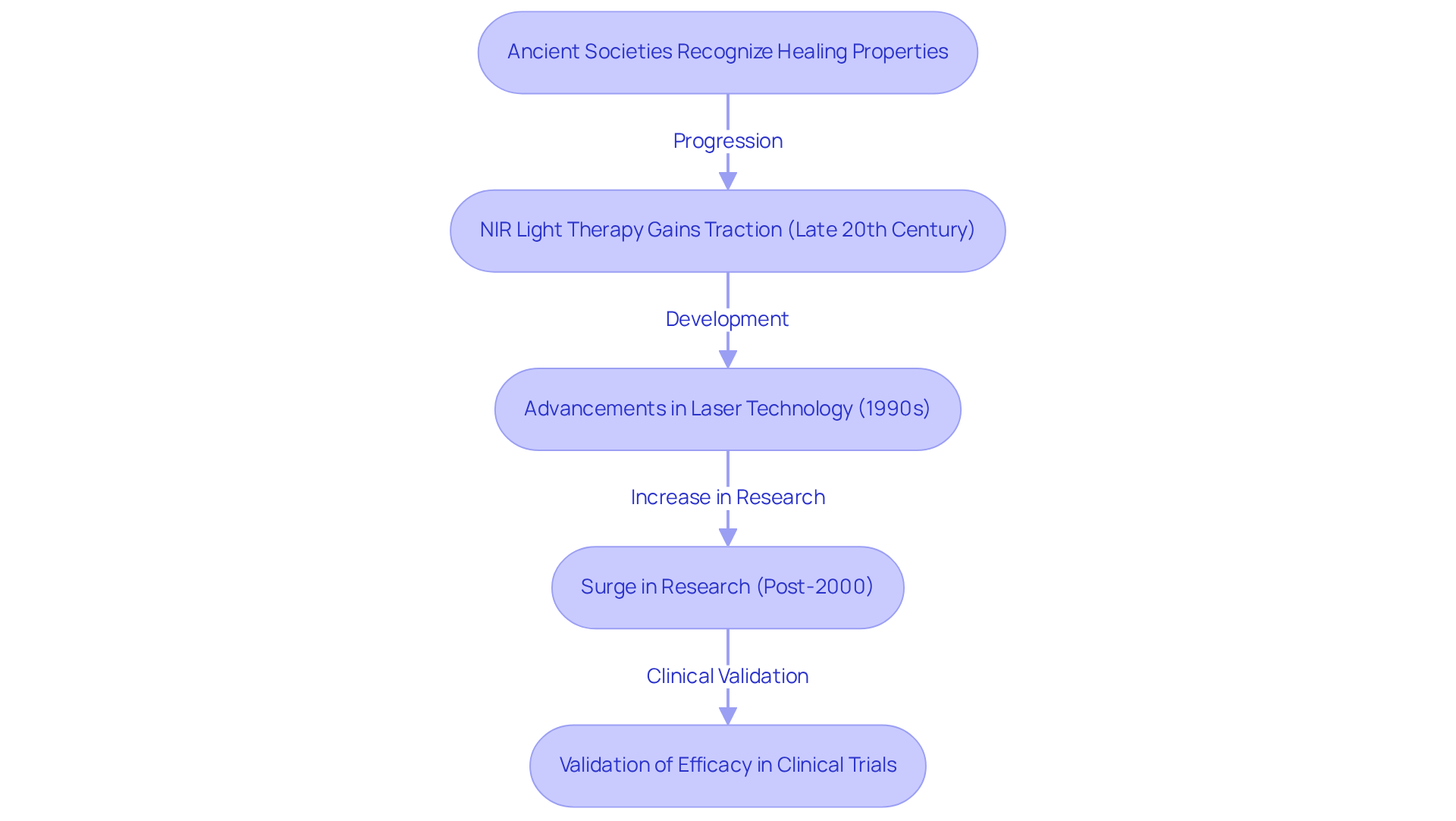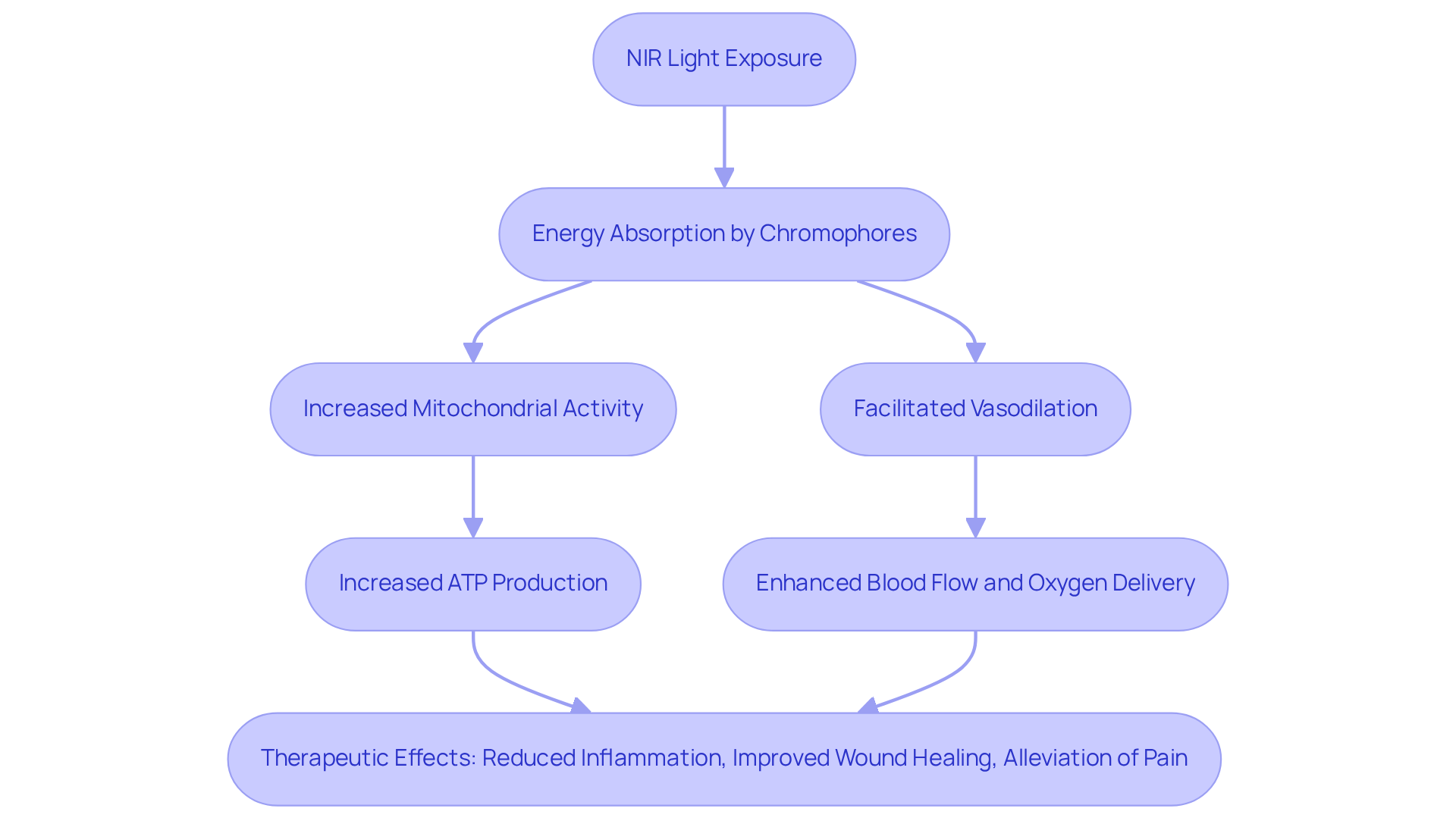Overview
NIR light, or Near-Infrared radiation, represents a crucial segment of the electromagnetic spectrum, renowned for its significant therapeutic role.
- Its unique ability to penetrate biological tissues effectively, without causing thermal damage, promotes recovery and reduces inflammation.
- This article highlights the diverse applications of NIR light in pain management and tissue repair.
- Furthermore, it cites FDA endorsements and numerous studies that validate its efficacy across various medical fields, establishing a compelling case for its use.
- Such evidence not only underscores the importance of NIR light in clinical settings but also invites further exploration into its potential benefits.
Introduction
Near-Infrared (NIR) light stands as a remarkable asset within the electromagnetic spectrum, emerging as a formidable tool in contemporary medicine. Its unique capacity to penetrate biological tissues without inflicting harm is transforming therapeutic practices, presenting promising avenues for:
- Pain management
- Inflammation reduction
- Accelerated healing
As the medical community increasingly adopts this innovative technology, a critical question arises: what precisely underpins the effectiveness of NIR light, and how can its potential be fully harnessed in the pursuit of improved health outcomes?
Define NIR Light and Its Therapeutic Importance
Near-Infrared (NIR) radiation, often discussed when considering what is NIR light, constitutes a crucial segment of the electromagnetic spectrum, positioned just beyond the visible spectrum, typically ranging from 700 nm to 1400 nm. This wavelength holds particular importance in medical contexts due to its remarkable capacity to penetrate biological tissues effectively, all without inflicting thermal damage. Increasingly recognized for its healing potential, what is NIR light plays a pivotal role in promoting recovery, alleviating inflammation, and enhancing cellular function. Its non-invasive characteristics render it an invaluable asset across various medical applications, notably in pain management and tissue repair.
Recent studies underscore that NIR radiation can penetrate several centimeters into biological tissues, showcasing its efficacy in accessing deeper layers without adverse effects. The FDA has endorsed red wavelength therapy, which incorporates what is NIR light, as a safe and effective treatment for conditions such as acne, muscle discomfort, and arthritis, further validating its therapeutic role.
Authorities in the field emphasize what is NIR light and its healing capabilities. Mark Sloan notably remarked, "There are probably no ailments that cannot be resolved or at least significantly improved using red and near-infrared wavelengths." This perspective reinforces the growing recognition of NIR illumination as a legitimate treatment modality in modern medicine, paving the way for innovative therapies centered on patient welfare. Moreover, ongoing research continues to affirm the efficacy of NIR illumination across diverse treatment scenarios, with over 50,000 studies published on red illumination therapy reporting no negative side effects. The optimal healing range of near-infrared radiation is acknowledged to be between 800-880 nm, further enhancing its medical utility.

Trace the History and Evolution of NIR Light Therapy
The therapeutic application of illumination has its roots in ancient societies, where various cultures recognized its healing properties. However, the specific application of therapy related to what is NIR light began to gain traction in the late 20th century. Initial research focused on the biological impacts of illumination on tissues, leading to the development of advanced phototherapy methods.
By the 1990s, advancements in laser technology, notably the introduction of the ruby laser in 1960, facilitated more precise applications of what is NIR light, especially in dermatology and pain management. Since the year 2000, research on red therapy has surged, yielding over 50,000 published studies that document its beneficial effects.
Clinical trials conducted during this period have validated the efficacy of NIR wavelengths, which relates to what is NIR light, in treating a variety of conditions, such as pain management and wound recovery, thereby fostering broader acceptance and integration into contemporary therapeutic protocols. This evolution reflects a growing acknowledgment of what is NIR light and its potential in enhancing patient care and improving health outcomes across diverse medical fields.
Notable figures, including William Herschel, who discovered near-infrared energy in the 19th century, alongside advancements in laser technology, have significantly contributed to the development of this field.

Examine the Mechanisms and Effects of NIR Light on Biological Tissues
What is NIR light? NIR therapy operates primarily through photobiomodulation, a process wherein energy is absorbed by chromophores within cells, triggering various biochemical reactions. This energy absorption significantly stimulates mitochondrial activity, leading to an increase in ATP production—an essential component for cellular energy. Furthermore, NIR radiation facilitates vasodilation, which enhances blood flow and oxygen delivery to tissues. Collectively, these mechanisms contribute to reduced inflammation, improved wound healing, and alleviation of pain, helping to define what NIR light technology is as a versatile instrument within therapeutic contexts.

Explore Practical Applications of NIR Light in Modern Medicine
NIR illumination treatment has revealed significant applications across various medical fields, leading to discussions about what is NIR light among professionals and researchers alike. In dermatology, it is employed to effectively treat:
- Acne
- Psoriasis
- Promote skin rejuvenation
In the realm of pain management, NIR radiation serves as a vital tool to alleviate chronic pain conditions, including:
- Arthritis
- Fibromyalgia
Furthermore, its role in physical rehabilitation is noteworthy, enhancing recovery from injuries and surgical procedures. Emerging research is now suggesting potential applications in:
- Wound healing
- Addressing neurological conditions
As studies continue to explore what is NIR light, the efficacy and versatility of NIR light therapy are poised to expand, reinforcing its importance in modern medical treatments.

Conclusion
Near-Infrared (NIR) light stands as a transformative force in modern medicine, demonstrating profound therapeutic potential across various applications. Its ability to penetrate biological tissues without causing harm facilitates healing processes, reduces inflammation, and enhances cellular function, establishing NIR light as a vital tool in pain management and tissue repair. The growing recognition of its efficacy underscores the significance of NIR light in contemporary healthcare practices.
This article highlights the historical evolution of NIR light therapy, tracing its origins from ancient healing practices to its modern clinical applications. With over 50,000 studies validating its safety and effectiveness, NIR light has firmly established itself as a legitimate treatment modality, particularly in dermatology and pain management. The mechanisms behind its therapeutic effects, such as photobiomodulation and increased ATP production, further illustrate its multifaceted role in enhancing patient care.
As research continues to unveil new applications for NIR light, the potential for its use in treating various conditions—including chronic pain, wound healing, and even neurological disorders—remains promising. Embracing NIR light therapy not only signifies a substantial advancement in medical treatments but also emphasizes the necessity for ongoing exploration and integration of innovative therapies that prioritize patient welfare. The future of healthcare may well hinge on harnessing the power of NIR light to improve health outcomes and enhance the quality of life for countless individuals.




